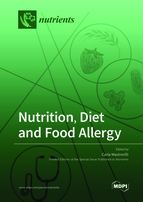Nutrition, Diet and Food Allergy
A special issue of Nutrients (ISSN 2072-6643). This special issue belongs to the section "Clinical Nutrition".
Deadline for manuscript submissions: closed (31 December 2021) | Viewed by 38139
Special Issue Editor
Interests: allergy; allergy diagnosis; allergens; allergic sensitization; children; diabetes mellitus; eczema; food allergy; nutrition; pediatrics
Special Issue Information
Dear Colleagues,
I would like to invite you to contribute to this Special Issue of Nutrients, addressing the topic‘Nutrition, Diet and Food Allergy’. Globally, food allergy affects 1.5% of adults and 5% of children and this prevalence is increasing in recent decades, representing a public health problem.
Different mechanisms are involved in food allergic diseases with distinctive clinical characteristics: IgE-mediated and non-IgE-mediated phenotypes will be distinguished in the Issue, considering the early recent literature on the prevalence, age of onset, follow-up recommendations and duration of food allergies.
Moreover, the management of these fascinating diseases will be discussed with particular attention on nutritional hazards, risks of allergic reactions to new allergens, problems with missed labelling (precautionary allergen labelling (PAL)). Especially, the dietary restrictions and the re-introduction of allergens lead to a significant burden for affected patients, fear of accidental ingestions and related risk of severe reactions, resulting in a reduced quality of life among patients with food allergies.
This Special Issue of Nutrients aims to collect an overview of the current body of evidence on the latest epidemiological, pathogenetic, and diagnostic findings on food allergies and the role of nutrition on the disease, in particular at pediatric age.
This information will provide novelties to health care professionals with a widespread, clear and update evidences in pediatric care.
I remain at your disposal for any further question.
Dr. Carla Mastrorilli
Guest Editor
Manuscript Submission Information
Manuscripts should be submitted online at www.mdpi.com by registering and logging in to this website. Once you are registered, click here to go to the submission form. Manuscripts can be submitted until the deadline. All submissions that pass pre-check are peer-reviewed. Accepted papers will be published continuously in the journal (as soon as accepted) and will be listed together on the special issue website. Research articles, review articles as well as short communications are invited. For planned papers, a title and short abstract (about 100 words) can be sent to the Editorial Office for announcement on this website.
Submitted manuscripts should not have been published previously, nor be under consideration for publication elsewhere (except conference proceedings papers). All manuscripts are thoroughly refereed through a single-blind peer-review process. A guide for authors and other relevant information for submission of manuscripts is available on the Instructions for Authors page. Nutrients is an international peer-reviewed open access semimonthly journal published by MDPI.
Please visit the Instructions for Authors page before submitting a manuscript. The Article Processing Charge (APC) for publication in this open access journal is 2900 CHF (Swiss Francs). Submitted papers should be well formatted and use good English. Authors may use MDPI's English editing service prior to publication or during author revisions.
Keywords
- Allergy
- Breastfeeding
- Children
- Food labelling
- Food allergy
- Maternal diet
- Nutrition
- Non-IgE mediated
- Rare allergic disorders
- Tolerance







